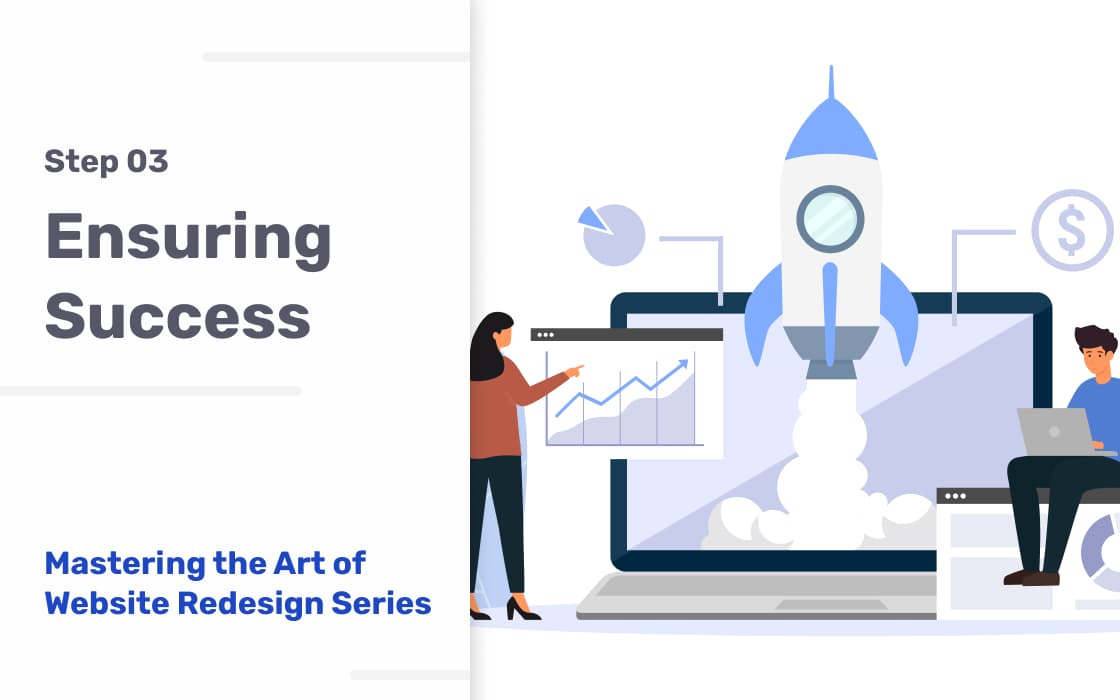Welcome back to our series on mastering the art of website redesign. In our previous discussions, I delved into the intricacies of scoping and aligning your project with your business objectives. Now, let’s pivot to the crux of making your redesign a resounding success.
I’m Shaun, and I bring to the table 25 years of navigating the ebbs and flows of web design and development. In this installment, we’ll unpack the best practices I’ve found indispensable in successfully steering website redesign projects. We’ll cover everything from choosing the right team to ensuring the technology aligns perfectly with your goals.
But it’s not just about the choices you make; it’s also about the wisdom you apply. That’s why I’ll share some veteran advice on crucial aspects like content management sanity, compliance from the get-go, and fostering forced communication – all essential ingredients in the recipe for a successful redesign.
So, whether you’re at the helm of your first redesign project or are a seasoned sailor in these waters, this article is designed to give you the insights and tools you need to navigate this journey successfully. Let’s dive in and explore how to make your next website redesign not just good but great.
Selecting the Right Design and Development Team
As someone who has navigated the waters of numerous redesign projects, I’ve seen firsthand the pivotal role of the project team. There have been instances where projects stumbled due to poor expectation setting, lack of communication, or vendors abandoning ship mid-way. One particular project, which stretched over two years to completion, came to mind, primarily because the client had limited time to contribute.
The crux of this experience is that most redesign projects are, at their heart, a collaborative effort. It could be a duo of a client participant and a singularly talented designer/developer, but success hinges on both parties working in tandem. With this perspective in mind, let’s explore how to find the right team for your project:
- Collaboration Expectations: A redesign project often means taking on an additional role. Prepare to dedicate significant time, mainly if your responsibilities include content creation, reviewing designs, or testing functionality. Regular progress meetings and interviews are a must; for more involved roles, you could invest 20-30 hours per week.
- Realistic Project Requirements: Conduct a thorough discovery process before choosing a vendor. This step is crucial to understand your project’s full scope and realistic timeline. It helps set clear expectations and ensures you’re well-informed about what the redesign entails from start to finish.
- Research and Referrals: While researching potential partners, consider factors like the technology stack, industry expertise, and required integrations. Look beyond the aesthetics in their portfolio. Evaluate whether their designs are content-manageable and perform efficiently. Visually appealing designs may not meet your practical needs or performance standards.
- Combination Teams: Don’t hesitate to consider a combination of creative and technical vendors. This approach can leverage both strengths, ensuring an outcome that’s visually appealing and technically sound. Divide the project scope so the creative team can hand it off to a development team experienced in your chosen CMS, CRM, or e-commerce system. This collaboration can lead to a successful, well-rounded outcome.
- Communication and Responsiveness: A successful collaboration hinges on open communication and responsiveness. Choose a team that values regular updates and quickly responds to your queries and concerns. This ongoing communication is vital for keeping the project on track and aligning with your vision.
Remember, the right team for your website redesign isn’t just about technical skills; it’s about finding professionals ready to collaborate closely, understand your business needs, and are committed to bringing your vision to life as efficiently and effectively as possible.
Finding the Right Technology Fit
Choosing the right technology for your website redesign is a pivotal decision, shaped by a variety of factors, including insights from the discovery process and the expertise within your internal team. I’ve encountered projects that hit roadblocks because the chosen platform needed custom development for functionality that existing plugins or modules couldn’t fully provide. Similarly, I’ve seen projects with high maintenance due to fragile technical approaches. Striking the right technological balance in a project can be challenging, particularly in the early stages when requirements still need to be fully understood or defined. To navigate these complexities, here’s some advice to help refine your technology discussions from the get-go.
- Assessing Technical Needs: Reflect on your website’s limitations and aspirations, a crucial part of the discovery process we recommended earlier. This assessment should guide your technological choices, ensuring they address both present shortcomings and future requirements.
- Open Source vs. Proprietary: Open Source platforms are highly customizable and offer community support (e.g., WordPress or Drupal). They are ideal for bespoke needs, provided you have the resources for ongoing development. Proprietary systems often come with robust support and are less demanding in terms of technical management (e.g., Adobe AEM). They suit businesses looking for more out-of-the-box solutions with dedicated support.
- Aligning with Business Goals: Ensure the selected technology supports your business objectives, enhancing key functionalities like user engagement or e-commerce efficiency.
- Scalability and Future Growth: Choose technology that won’t just serve you today but will be adaptable as your business grows, preventing the need for frequent major overhauls.
- User-Friendly CMS: Consider your team’s familiarity with potential CMS options. Their comfort with a specific system can significantly influence your choice, balancing user-friendliness with internal expertise and ease of content management.
- Integration Capabilities: Integration with existing systems is critical. Seamless connectivity between your new website and current operational tools is essential for a cohesive experience.
- Expert Consultation: Consulting technology experts can provide valuable insights, particularly in balancing trendiness with practical long-term functionality.
Selecting the right technology is more than just following trends; it’s about finding a solution that aligns with your unique business needs, team capabilities, and vision uncovered during your discovery process.
Key Advice from a Veteran
Drawing on extensive experience in website redesigns, here are some essential pieces of advice to navigate your project successfully:
- Content Gathering/Production Sanity: A simple spreadsheet and shared file storage may suffice for smaller projects. However, you need a robust system for larger-scale projects with hundreds or thousands of pages. This system should efficiently manage content from multiple authors, track editorial status, and handle translations or variants. The complexity increases with the project size, so choose a system that will be manageable for your team and can handle these nuances effectively.
- Compliance From the Start: Compliance should be a consideration from the design phase. Address simple issues like color contrast for ADA compliance by testing early and often, even before coding begins. Similarly, template designs should be evaluated for compliance with Google’s Core Web Vitals and other browser/device considerations. This proactive approach ensures compliance is integrated into every stage of the project.
- Forced Communication: Regular project status meetings are essential to ensure consistent face-to-face interaction. Consider more frequent check-ins for quicker feedback loops depending on the project phase. Be flexible to scale these meetings up or down as the project progresses. Clear communication channels other than email can enhance clarity and encourage sharing ideas that lead to those high-five moments.
- Prioritize User Experience: It’s common for organizations to need help with viewing their website from their audience’s perspective. For instance, healthcare websites might use overly medical terminology instead of language that is more accessible to the general public. Always approach your website with your audience’s understanding and needs in mind.
Implementing these practices can significantly enhance the process and outcome of your website redesign project. They ensure the project remains user-focused, compliant, and efficiently managed, leading to a successful and impactful website.
Conclusion
In this journey through the best practices for website redesign, we’ve covered crucial steps, from selecting the right team and technology to specific strategies for ensuring project success. Remember, the key lies in a blend of meticulous planning, clear communication, and a user-centric approach.
Effective content management systems cater to projects of all sizes, ensuring a smooth content workflow. Starting from the design phase, compliance considerations pave the way for an accessible and legally sound website. Regular, structured communication keeps everyone on the same page, fostering an environment where ideas can flourish, and challenges are addressed promptly. Lastly, always view your website through the lens of your audience to create an engaging and intuitive user experience.
With these insights, your website redesign project is poised for completion, success, and impact. By adhering to these best practices, you’re setting up your project to be a harmonious blend of form, function, and strategic vision.
Mastering the Art of Website Redesign Series
Pitching the Redesign
Delve into leveraging analytics, competitive analysis, and understanding your business’s goals to build a convincing case

